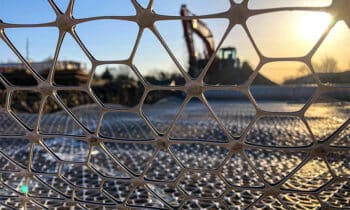
Calculate the effectiveness of fourth-generation geogrids yourself
In civil engineering, geogrids are widely used because it ultimately brings significant cost and environmental benefits over classical solutions. Tensar recently presented the fourth generation of geogrids and also updated the SPDs. Curious about what its application will bring to your project? Calculate for yourself the effectiveness of a Tensar solution through online software Tensar+.
Applying innovative mechanically stabilizing geogrids broadly results in two improvements, begins Paul ter Horst of Tensar. "First, the use of foundation material and/or asphalt is reduced, which results in fewer vehicle and machine movements for supply or removal, and therefore less CO2- and nitrogen emissions on any construction project. In addition, geogrids increase the useful life of traveled surfaces, decrease maintenance and delay reconstruction. So construction, investment, management and social costs go down significantly."
MKI score
To determine the MKI score of a geogrid solution in GWW, a full A to D EPD is required. "The product-specific environmental document, or Environmental Product Declarations (EPD), changed as of July 2022. The EPD must be included in the National Environmental Database (NMD) in order to determine a valid MKI score in DuboCalc, among other things," Paul knows. "The EPDs of all our geogrids were updated before 2023. Moreover, according to the current design guideline in the Netherlands, geogrids must be full scale tested in order to determine at all what a pavement construction should be." Reason for Tensar to perform new Life Cycle Assessments (LCA), additional testing and substantiated independent reporting on its products in accordance with the design methods in the CROW publication C1001 'Geosynthetics as foundation reinforcement in unbound foundation layers'.

Tensar+
Tensar produces several types of geogrids. "Some lend themselves more to steep slopes or walls, others to application in roads and still others for under railroad tracks or in a crane siding," Paul outlines. "Some products combine two applications and can be used both horizontally and vertically. However, the lack of publicly available design software limits the application of our innovative solutions. That is now a thing of the past with Tensar+." This is a free and freely available cloud-based road and geotechnical design software that allows engineers, contractors and clients to mirror the effectiveness of Tensar geogrids against an application without a geogrid. "Users can enter their own parameters for a project-specific comparison based on money, time, CO2-emissions and soon the MKI value."
Tensar's main product for achieving stable foundations is the new Tensar InterAx. According to Paul, the newest and most advanced form of geogrid stabilization available on the market. "The optimized geometry provides better confinement of the aggregate and creates a more efficient stabilized layer, resulting in better performance and more cost savings than all previous Tensar geogrids. With the best performance of all types of foundation geogrids, Tensar InterAx can give much higher load spread and/or strength. In this way, you therefore need to apply less material at the same traffic load and service life, but you could also extend the service life considerably up to a factor of 5. These are trade-offs that we can substantiate perfectly with our new cloud-based software Tensar+."
Heeft u vragen over dit artikel, project of product?
Neem dan rechtstreeks contact op met Tensar International BV.
 Contact opnemen
Contact opnemen




